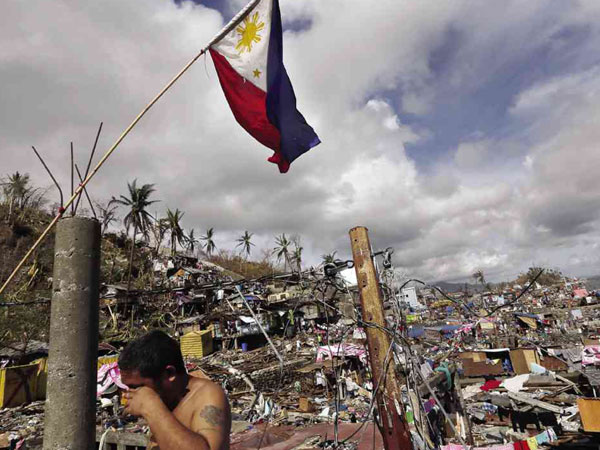Philippines’ 10 deadliest storms

A survivor wipes his face before a Philippine flag in typhoon-ravaged Tacloban, a city short of food and water, and littered with countless bodies. AP FILE PHOTO
MANILA, Philippines–Typhoon Ruby (Hagupit) was on Sunday churning across the Philippines, the latest in a never-ending series of often-deadly storms that plague the Southeast Asian archipelago.
With more than 7,100 islands, the country is hit by an average of 20 typhoons or tropical storms each year.
The storms are created above the warmer waters of the Pacific Ocean near the equator, and the Philippines’ islands are often the first major landmass they hit as they move northwest.
The following are the 10 deadliest typhoons on record in the Philippines*.
- Super Typhoon Yolanda (Haiyan), the strongest storm ever recorded on land, destroys entire towns across the central Philippines on November 8, 2013. When the government stopped its count months later, more than 7,350 people were listed as dead or missing.
- Tropical Storm Uring (Thelma) unleashes flash floods on the central city of Ormoc on Leyte island on November 15, 1991, killing more than 5,100.
- Typhoon Pablo (Bopha) smashes into the main southern island of Mindanao on December 3, 2012. Rarely hit by major storms, the unprepared region suffers about 1,900 people dead or missing.
- Typhoon Nitang (Ike) hits the central Philippines on August 31, 1984, killing 1,363 people.
- Typhoon Sendong (Washi) hits the northern part of Mindanao island on December 16, 2011, killing at least 1,080 people.
- Floods and landslides unleashed by Typhoon Trix kill 995 people in the Bicol region of the main island of Luzon on October 16, 1952.
- Typhoon Amy rakes across the central islands in December, 1951, with floods, landslides and a massive storm surge killing 991 people.
- Typhoon Sisang (Nina) hits the eastern city of Legaspi on November 25, 1987, triggering giant storm surges and unleashing mudslides down Mayon volcano that claim 979 lives.
- Typhoon Frank (Fengshen) tracks an erratic and destructive path across the central islands and nearby areas from June 20, 2008, killing 938 people.
- Typhoon Rosing (Angela), with gusts of up to 260 kilometers an hour, causes carnage in Bicol and later Manila from November 2, 1995, killing 936 people.
* Data is from government records and those compiled by David Padua, a meteorologist for weather forecasting website The Weather Philippines Foundation.